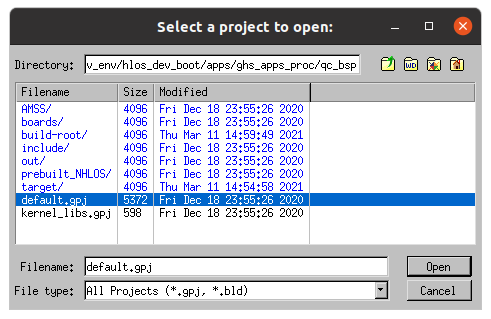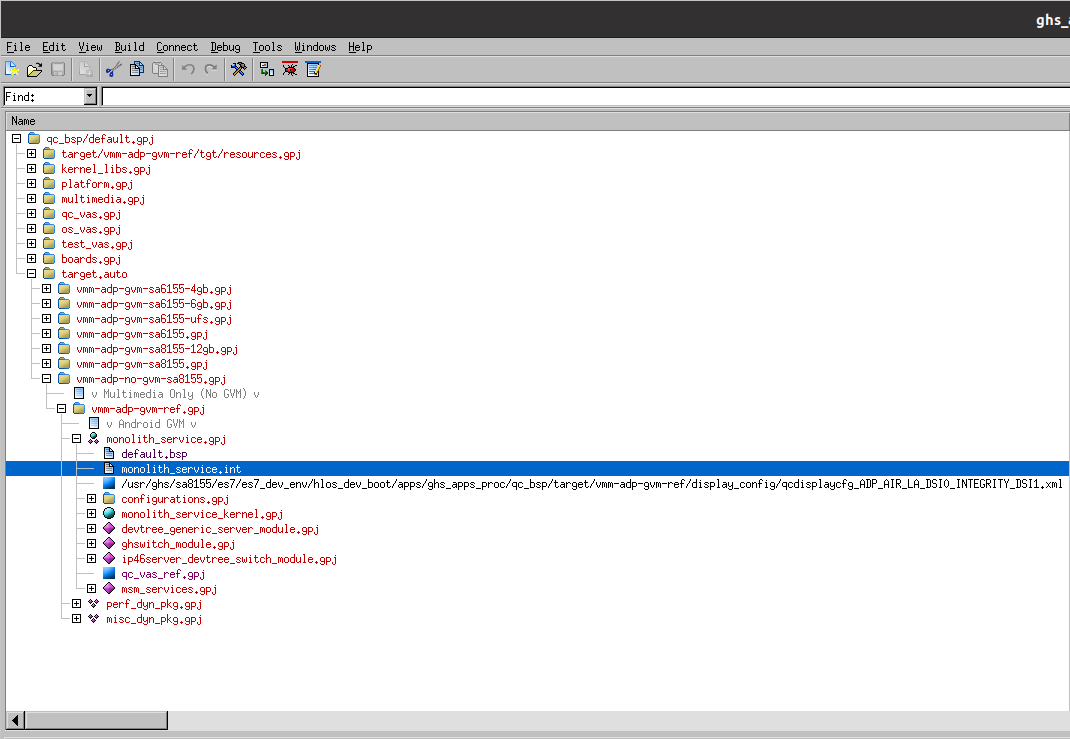モノリスプロジェクトのビルド
このチュートリアルでは、Qtサンプルアプリケーション用のモノリスINTEGRITYプロジェクトをビルドする方法を説明します。サポートされているQtモジュールを使用するQtサンプルアプリケーションを選択してください。
モノリスINTEGRITYプロジェクトをビルドする前に、setEnvironment.sh スクリプトを実行してビルド環境を準備してください。このスクリプトの詳細については、Creating a set environment shell script を参照してください。
source ~/setEnvironment.sh
Qt アプリケーションのビルド
CMakeツールCMake を使用して Qt6 に対してアプリケーションをビルドするには、ターミナルで次のコマンドを実行します:
<Qt installation path>/bin/qt-cmake <Qt example application path>/CMakeLists.txt cmake --build .
ここで、
qt-cmakeは、適切なインクルード・パスでプロジェクトを構成するために CMake を呼び出すラッパースクリプトです。qmakeツールqmakeを使用してQt6に対してアプリケーションをビルドするには、ターミナルで以下のコマンドを実行します:
<Qt installation path>/bin/qmake <Qt example application path>/application.pro make
モノリスプロジェクトのビルド
Qualcomm Snapdragon 8155Pボード用のボードサポートパッケージ(BSP)は、ボードパーティション用のイメージセットを作成するビルドスクリプトを提供します:
/work/ghs/sa8155/es7/es7_dev_env/hlos_dev_boot/apps/ghs_apps_proc/build_ghs.sh
monolith-service.intファイルにQtアプリケーションを追加して、ビルドに追加します:
- MULTI Launcherを起動します。
- Components >Open Project Manager を選択します。
- work/ghs/sa8155/es7/es7_dev_env/hlos_dev_boot/apps/ghs_apps_proc/qc_bspディレクトリのプロジェクトファイルdefault.gpjを選択します:

MULTIアプリケーションは、選択したフォルダのプロジェクトファイルのリストをウィンドウに表示します。
- Open を選択します。
MULTI Project Managerビューに、開いたプロジェクトのツリー構造が表示されます。
default.gpj のサブプロジェクトに進みます:
- target.auto vmm-adp-no-gvm-sa8155.gpj>vvm-adp-gvm-ref.gpj>monolith-service.gpj を選択します。プロジェクトの構造を観察し、プロジェクトのファイルを編集することができます。
- monolith-service.intを選択

選択したmonolith-service.intファイルがプロジェクトツリーでハイライトされます。
- ファイルを右クリックし、コンテキストメニューからEdit を選択します。
- ファイルの最後に以下の行を追加します。
AddressSpace Name myappname Filename /path/to/your/app/executable MemoryPoolSize 0x2700000 Language C++ HeapSize 0x90000 Task Initial StackSize 0x80000 StartIt false EndTask Extendedmemorypoolsize 0x300000 EndAddressSpace
注: </path/to/your/app/executable> は、アプリケーションの実行ファイルへのパスに置き換えてください。
- ビルドスクリプトを実行します。
bash /work/ghs/sa8155/es7/es7_dev_env/hlos_dev_boot/apps/ghs_apps_proc/build_ghs.sh
これで、monolith プロジェクトをボードにフラッシュする準備ができました。
© 2025 The Qt Company Ltd. Documentation contributions included herein are the copyrights of their respective owners. The documentation provided herein is licensed under the terms of the GNU Free Documentation License version 1.3 as published by the Free Software Foundation. Qt and respective logos are trademarks of The Qt Company Ltd. in Finland and/or other countries worldwide. All other trademarks are property of their respective owners.

